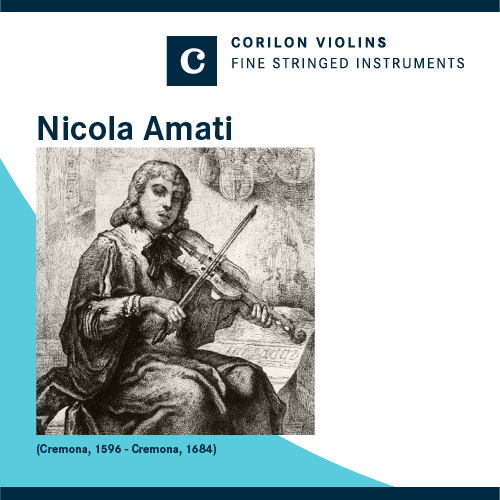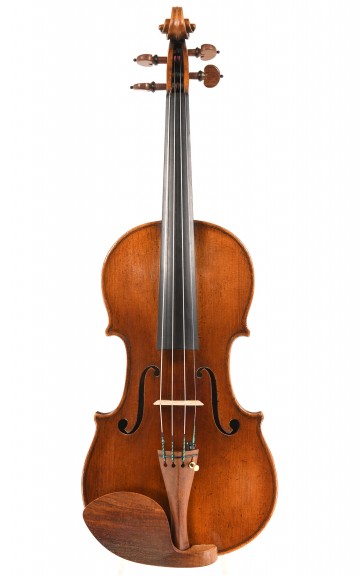Nicolo Amati and the Amati dynasty of violin makers
The Amati dynasty of luthiers dominated the world of stringed instruments for over 100 years in Cremona, making critical contributions to the development of the modern violin model – in conjunction with Antonio Stradivari, who based his work on the entire Amati family oeuvre, perfected the design and construction principles of the violin, and elevated them to their current standard.
- Andrea Amati and the "invention" of the modern violin
- The details of Andrea Amati's violins
- Antonio and Girolamo Amati: the Amati brothers
- Nicolò Amati
- The “great Amati” model by Nicolò Amati
Andrea Amati and the "invention" of the modern violin
Andrea Amati was born around 1505, and contrary to the statements of earlier music scholars, he probably was not a member of the family of patricians that shared the name. It is thus unclear whether Amati already had the financial means as a young master that would have allowed him to acquire top-tier tone woods from Venice; if so, this would have served as a partial explanation for his ability to establish his workshop so quickly. It is likely, however, that Amati simply profited from the rapid development which was taking place in the musical culture of Renaissance Italy, and the quality and style of his instruments clearly appealed to the wealthy upper class as well as religious dignitaries and institutions that were making significant investments in their artistic representation.
One of Amati's better decisions in this context was to focus his efforts on making stringed instruments, a choice that was by no means a matter of course during his training with Giovanni Liunardo da Martinengo. Like the luthiers of his generation – and the majority of those that followed in later generations – he certainly started out by learning the art of making plucked stringed instruments first and foremost, only to shift his attention to the violin family with unparalleled focus, and in pursuing this endeavour in depth, he ultimately wrote musical history.
The details of Andrea Amati's violins
Andrea Amati is widely considered the "inventor" of the violin, although his historic achievement, like most of the major accomplishments in human history, was by no means an inspiration that occurred in a vacuum. Instead, he succeeded in introducing dynamic innovations in the violin models of his day; at that time, the design of these violins was still rooted in the late mediaeval period which had just ended and which was undergoing a process of constant transition, as were so many other elements of European culture at that time.
His trail-blazing and bold modifications included changing the position of the bridge, which Amati placed higher and closer to the fingerboard, thus reducing the resonant length of the strings in comparison to the older viola-da-braccio models. By also moving the sound holes further down the body and changing their shape, he created important and immediately conspicuous determinants of the new style of violin, which probably also included the standardised shape of the scroll (a feature that can likely be attributed to Amati as well). Another aspect that had an even more vital effect on the acoustic properties of the violin was a technical innovation which was not visible in and of itself: presumably Amati applied construction principles he had learned from the lute, and by building an inner substructure, he succeeded in creating much thinner walls and smaller areas to be glued, which dramatically improved the resonant properties of the entire body.
The most likely factor in the massive success of Amati's workshop was probably the huge advancements he made in the quality of the sound, a phenomenon for which Andrea Amati's work was renowned. Amati violins were leap years ahead of their time, musically speaking, given that in this phase of musical history there was not yet any solo literature which allowed performers to exhaust the possibilities of their instruments, especially in terms of using the full fingerboard.
The international success of Amati violins is due in no small part to the musicians who came to know Amati's work in Cremona and took it with them to faraway lands as they played. Researchers are still debating whether the legendary large-scale commission of richly ornamented instruments for Jean-Baptiste Lully's orchestra at the French royal court actually occurred; the order was said to have been arranged by Catherina de Medici. What remains uncontested, however, is the historic influence which Amati and his oeuvre had on all subsequent generations of luthiers.
Antonio and Girolamo Amati: the Amati brothers
The first of Andrea Amati's immediate successors were obviously his two sons, Antonio and Girolamo Amati, who optimised their father's violin model and refined it to perfection. Like their father, the brothers, who gave their instruments a shared label, focused exclusively on crafting stringed instruments.
After their father's death in 1577, it became apparent that his sons were truly worthy heirs in terms of their willingness to experiment and their creativity, and consequently they were successful in implementing significant improvements to the Amati model in every significant area.
In addition to refining the purfling and harmonising the silhouette, they also narrowed the sound holes and enhanced the acoustics of how the table was designed; in comparison to their father's work, they increased the edge fluting, thus achieving not only an improvement in aesthetics but an increase in the tension of the top, which in turn contributed to the greater responsiveness and acoustic appeal of their work. The enduring historic accomplishments of the brothers Amati include, amongst other things, establishing a smaller size from the viola, a standard which Stradivari immediately implemented and which has remained the prevailing benchmark to this day.
Like nearly every other biography of a non-member of the nobility during this period, there are several unanswered questions about the Amati brothers' lives, the greatest of which is likely to be why Antonio sold his stake in the workshop to Girolamo. This transfer was documented as having occurred in 1588, which was only 11 years after Andrea Amati's death, yet the incident does not appear to have had any impact on their work together, which apparently continued unaffected. Even after Antonio's death in 1607, Girolamo continued to use their shared violin label until 1630, the year in which he himself fell victim to the plague.
Nicolò Amati
The success of Antonio and Girolamo Amatis' workshop had created the ideal prerequisites for any successor – especially if they, like Girolamo's son Nicolò, had learned the trade from childhood onward at one of the leading violin-making workshops in Italy. Nevertheless, the 34-year-old master found himself in difficult straits after the unexpected death of his father. Northern Italy had been ravaged by famine and plague, and after Maggini in Brescia succumbed to the disease as well in 1632, Nicolò found himself operating the last of the truly superior violin-making ateliers in the country. It is not known in detail how he coped with this situation, which was probably quite overwhelming and marked by a chronic lack of staff, yet it is striking that very few instruments have survived from the first decade of that period.
Despite all of these obstacles, Nicolò Amati used this time to fundamentally reorient himself ― very much in keeping with the tradition of his family, which had taken times of transition in their biography to review previous generations' achievements and make important optimisations to the prevailing Amati model of each respective time. Whereas he still crafted instruments in his father's style between 1630 and 1640 and labeled them accordingly, at the same time Nicolò was laying the cornerstone for a "new Amati" which would ultimately have the same significance in the history of violin making as his grandfather's innovative choices did.
The “great Amati” model by Nicolò Amati
The fundamental re-interpretation of Andrea Amati's violin model was the cornerstone for the enduring financial success that lead Nicolò Amati's workshop out of the period of crisis whilst also paving the way for the works of the Cremonese school that followed.
The main definitive modifications included reinterpreting and lowering the table whilst increasing the tension of the top, which Nicolò achieved by making the edge fluting – one of his father's and uncle's most important innovations – even deeper. This development along with the higher ribs created a new sound in the violin which corresponded to the performance standards of that period: multiple choruses and large-scale orchestras.
Nicolò Amati also made history in his work as a teacher and is the master to whom the great figures of the Cremonese school owe their training and inspiration. Even though there is little direct evidence of Francesco Ruggeri, Andrea Guarneri and Antonio Stradivari training at Nicolò Amati's workshop, there can be no doubt whatsoever about his massive influence upon them. And it is also quite probable that he thus created the intense competition in Cremona which made the life of Girolamo II Amati, his son and student, so difficult and ultimately dimmed the bright light of the Amati family starting in the 17th century.
Related articles:
Italian violins in Corilon violins online catalog
Markneukirchen: violin making in “German Cremona”
International violin making competitions -- an overview
Contemporary violin makers - the modern artisans
Samuel Zygmuntowicz: understanding Stradivarius
How to select a violin, provenance, value and violin appraisal






